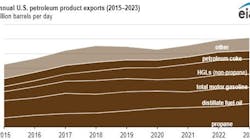Global oil demand will rise to 99 million b/d in 2035 from 87 million b/d in 2010, with all the net growth coming from transportation in emerging economies, the International Energy Agency forecasts in the 2011 edition of its World Energy Outlook (WEO).
And natural gas demand over the forecast period will capture a larger share of the world’s energy mix, nearly catching up to coal demand, according to the WEO.
The worldwide passenger vehicle fleet will double to almost 1.7 billion vehicles in 2035, but alternative technologies, such as hybrid and electric vehicles that use oil more efficiently or not at all, will continue to advance but take time to penetrate markets, IEA said.
In WEO’s central New Policies Scenario, primary energy demand will increase by one-third between 2010 and 2035, with 90% of the growth in developing economies outside the Organization for Economic Cooperation and Development.
IEA said China will be the world’s largest energy user, consuming nearly 70% more energy than the US by 2035, even though by then per capita demand in China still will be less than half the level in the US.
The share of fossil fuels in global primary energy consumption is forecast to fall to 75% in 2035 from around 81% currently. Demand for renewable sources of energy will increase to 18% in 2035 from 13% of the mix currently. The growth in renewables is underpinned by subsidies that rise to $250 billion in 2035 from $64 billion in 2010, support that in some cases cannot be taken for granted in this age of fiscal austerity, IEA said, noting that subsidies for fossil fuels totaled $409 billion in 2010.
Short-term pressures on oil markets are easing with economic slowdown and the expected return of Libyan supply. But the average oil price will remain high, approaching $120/bbl in 2010 dollars in 2035.
Reliance on a small number of oil producers will grow. The increase in output from Middle East and North Africa (MENA) is more than 90% of the required growth in world oil output to 2035, according to the WEO. If investment in the MENA region between 2011 and 2015 runs one-third lower than the $100 billion/year required, consumers could face a near-term rise in the oil price to $150/bbl, the report said.
By 2035 the use of coal—which met almost half of the increase in global energy demand over the last decade—will climb by 65%. Meanwhile, the accident at Japan’s Fukushima Daiichi nuclear plant has raised questions about the future role of nuclear power. In the WEO’s New Policies Scenario, nuclear output rises by over 70% by 2035, only slightly less than projected last year, as most countries with nuclear programs have reaffirmed their commitment to them.
Future of natural gas
WEO said the future for natural gas is more certain, as its share in the energy mix rises and demand almost catches up with coal consumption.
One country set to benefit from increased demand for gas is Russia, but key challenges for Russia are to finance a new generation of higher-cost oil and gas fields and to improve its energy efficiency, the report said.
“While Russia remains an important supplier to its traditional markets in Europe, a shift in its fossil fuel exports towards China and the Asia-Pacific gathers momentum. If Russia improved its energy efficiency to the levels of comparable OECD countries, it could reduce its primary energy use by almost one-third, an amount similar to the consumption of the UK. Potential savings of natural gas alone, at 180 billion cu m, are close to Russia’s net exports in 2010,” IEA said in the report.
“Growth, prosperity, and rising population will inevitably push up energy needs over the coming decades. But we cannot continue to rely on insecure and environmentally unsustainable uses of energy,” said IEA Executive Director Maria van der Hoeven.
“Governments need to introduce stronger measures to drive investment in efficient and low-carbon technologies. The Fukushima nuclear accident, the turmoil in parts of [MENA], and a sharp rebound in energy demand in 2010, which pushed [carbon dioxide] emissions to a record high, highlight the urgency and the scale of the challenge,” van der Hoeven said.

